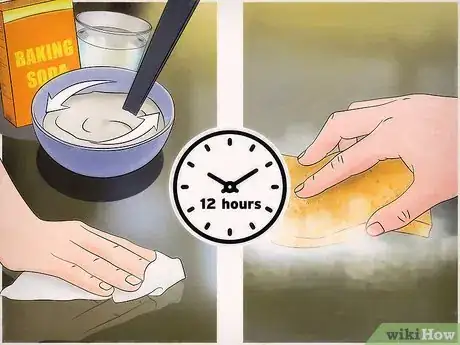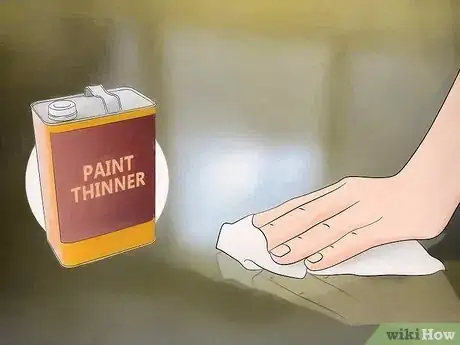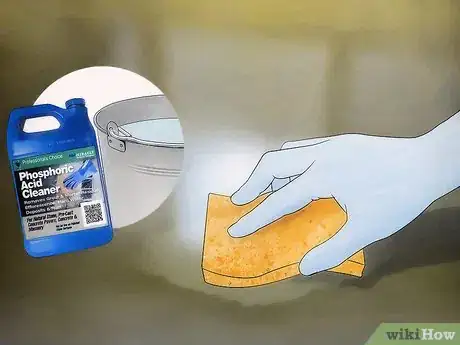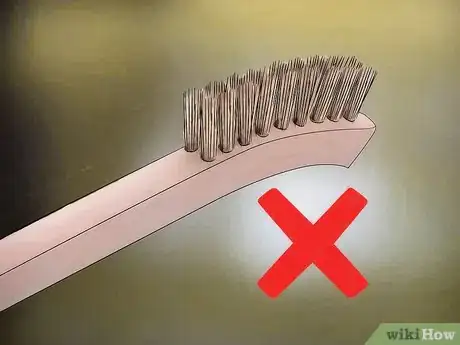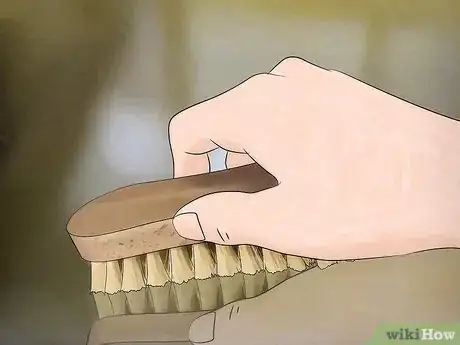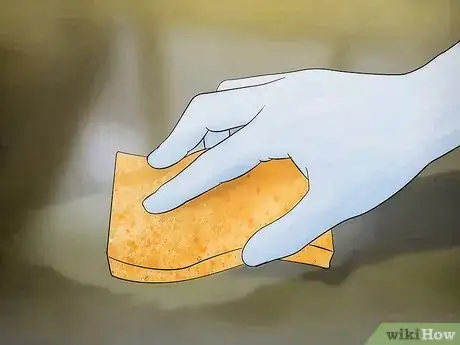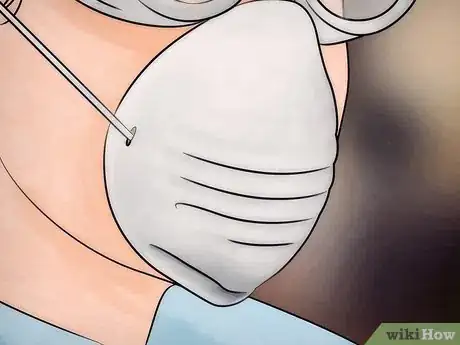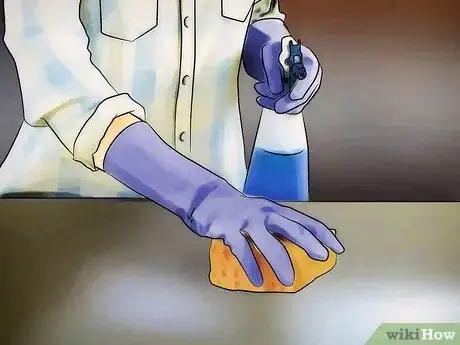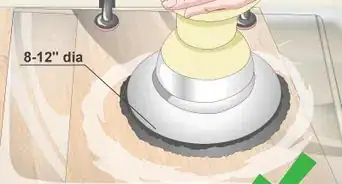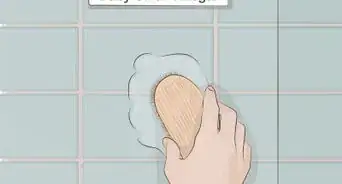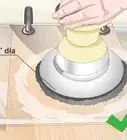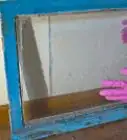This article was co-authored by Michelle Driscoll, MPH. Michelle Driscoll is the Owner of Mulberry Maids, which is based in Fort Collins, Colorado. With five years of experience, her business specializes in cleaning homes and small offices. She holds a Masters in Public Health from the Colorado School of Public Health. Additionally, Mulberry Maids has an A+ rating from the Better Business Bureau.
There are 8 references cited in this article, which can be found at the bottom of the page.
wikiHow marks an article as reader-approved once it receives enough positive feedback. In this case, 87% of readers who voted found the article helpful, earning it our reader-approved status.
This article has been viewed 201,095 times.
Fiberglass is a synthetic fiber that consists of a plastic resin formed together with glass fibers. A wide variety of items found in homes and workplaces are made from fiberglass, including sinks, showers, bathtubs, lighting fixtures, and boats. There are specific ways to keep fiberglass items in your home clean and free from stains. Work safely, because fiberglass can be hazardous to your skin and lungs.
Steps
Choosing the Right Cleaning Solution
-
1Start with a mild cleaner, like dishwashing liquid. Dishwashing liquid will cut through most grease and oil stains. Don't use automatic dishwasher detergent, since it can be too abrasive for fiberglass.[1]
- Your detergent or cleaner should not have any bleach in it. Bleach can also damage fiberglass, so verify that it's not an active ingredient in your mild cleaner.
- You can also make a homemade cleaner easily by combining vinegar with regular dish detergent. This cleaner may work particularly well in showers.[2]
-
2Use baking soda to tackle caked-on dirt. Mix baking soda with water to form a paste that can be used to remove dirt on surfaces like a shower door or sink. Apply it to the soiled area and leave it in place for at least 12 hours.[3] Follow up by cleaning the area with soapy water.
- The paste may turn a brownish color when it sits on the dirtier areas of fiberglass.
- You can use vinegar to activate the baking soda after it sits on a fiberglass surface for deeper cleaning power. It should bubble a little, after which you can wipe down the fiberglass to get rid of the baking soda and dirty stains.
Advertisement -
3Remove paint stains with acetone or paint thinner. Both of these substances can be dangerous, so be careful when you are using them. Acetone and paint thinner should only be used for stains such as oil or paint.
- Since these materials can harm the fiberglass, only use them to tackle especially bad stains. Spot clean using acetone and paint thinner, so you don't damage any areas not heavily stained.
- Wear thick gloves when cleaning using acetone or paint thinner. It may be good to wear goggles as well, so you don't get either substance in your eyes.
-
4Try phosphoric acid (rust remover) for hard water stains. It can be dangerous, so be careful when handling rust remover. Mix it with water so the rust remover is not strong enough to damage your fiberglass.[4]
- Dilute rust remover with water by about 10% to make it less dangerous to handle. Mix carefully before applying to any fiberglass surfaces.
- Since this can be a dangerous cleaner, make sure to wear rubber gloves. Rinse the fiberglass surfaces immediately with water when applying the rust remover; don't let it sit on the fiberglass for long.
- As a safer alternative, try cleaning water stains with a paste made of white vinegar and baking soda. Let the mixture sit on the stain for an hour before gently scrubbing the surface and rinsing it with clean water. Add a drop of liquid soap or hydrogen peroxide for extra cleaning power.[5]
-
5Try wax, silicone, or detergent for fiberglass boat surfaces (but note that silicone will make any subsequent repairs very difficult). If you have a fiberglass boat, you'll likely want it to shine when in the marina or on the water. You can find these cleaners at marine stores, and the employees can usually suggest the best kind for your particular boat.
- A good boat wax polish will create a protective shield on the gel-coat fiberglass surface, protecting the boat from the elements. This will stave off any damage from the water and keep your boat looking nice.
- Older boats with fiberglass surfaces that have seen a lot of use might do better with a silicone polish, which sinks into the surface better. If your boat is older or used, you may also want to clean it on a more regular basis.
- If you remove your fiberglass boat from the water after each use, wash it down thoroughly with a mild detergent and rinse thoroughly after each outing. This is especially important if your boat is in saltwater. Saltwater can really damage a boat's fiberglass surfaces.
- If there’s any mildew on the boat, add 1 cup (240 mL) of bleach per 1 gallon (3.8 L) of your cleaning solution to kill it.[6]
Using the Proper Cleaning Technique
-
1Avoid using scouring brushes or wire brushes when regularly cleaning fiberglass. These will scratch and ruin the gel-coat surface of the fiberglass. Even though your stains may be deep, harsh brushes are not the best solution to get rid of the stains.
- Don't use steel wool, scrapers, or scouring pads, either. These cleaning tools are also too harsh for fiberglass surfaces.
-
2Gently rub your fiberglass cleaner on with a cloth or soft nylon brush. Make sure the brush has plenty of give against the fiberglass surface. Fiberglass can be scratched easily, so be especially gentle even with tough stains.
- Try using a circular motion when scrubbing fiberglass surfaces. This will ensure you don't damage the fiberglass underneath.
- For tougher stains, you can use a heavier cloth. However, it should still be soft enough to prevent damage.[7]
-
3Use a sponge for especially difficult stains. Sponges may be good if you need to let your cleaner sit for a while. Use a soft sponge without any abrasive surfaces.
- It may be especially useful to use a sponge when using baking soda paste. When using baking powder paste, the cleaner needs to sit awhile before you mix it with vinegar.
- The sponge can soak up the cleaner from the fiberglass surface. It can also wipe stains from the fiberglass surface.
-
4Apply white polishing compound to your boat with a soft cloth. Use a clean cloth and be especially gentle when applying the polish. Ideally, the polish should leave your fiberglass surface with a clean, white sheen.
- Only apply the white polish compound with a soft cloth after cleaning the fiberglass. The polish should be the final step in your cleaning procedure.
- Use the white polishing compound a few times a year to keep the fiberglass sparkling. The polish should be applied when the boat has been out a few times or has sat for a while.
Practicing Caution Around Fiberglass
-
1Wear a mask when cleaning fiberglass. Inhaling fiberglass dust, which is produced whenever fiberglass is damaged, cut, broken or sanded, can be dangerous. Though the irritation from fiberglass dust is temporary, it is also very unpleasant.
- Exposure to the fibers and the dust in fiberglass can produce skin, eye, or respiratory tract irritation. It does not cause long-term problems in most cases, but can lead to painful irritation.
- This exposure could become serious depending on the length of exposure and the size of the fibers that you come into contact with. Fiberglass dust can cause internal damage, though this is extremely rare when only cleaning fiberglass.
-
2Use protective clothing when cleaning fiberglass. Fiberglass can also cause skin irritation. It can even leave a rash on your skin in the case of long-term exposure. Wear long sleeves each time you work with fiberglass and change into clean clothes afterwards. The long sleeves should prevent your arms from being exposed, while changing your clothes will ensure you don't retain any fiberglass dust on your person.[8]
- Minimize the amount of bare skin that can be exposed to fiberglass. Gloves, long sleeves, and pants are necessary when working intensively with fiberglass.
- Launder the clothes you wear when cleaning fiberglass separately from your other clothes. Fiberglass dust can get into your other clothes if you're not careful.
-
3Wear protective goggles when working with fiberglass. Eye irritation and damage is also a serious problem with fiberglass. Eye irritation can be much more serious than inhaling fiberglass dust, since it is more likely to cause permanent damage.
- Particles from fiberglass can get into your eyes and irritate them. Wearing goggles should minimize the contact with fiberglass and keep your eyes safe.
- Sharper fiberglass fragments can also severely damage your eyes if you do not protect them. They can cut your eyes and even lead to long-term damage or issues.
Expert Q&A
Did you know you can get expert answers for this article?
Unlock expert answers by supporting wikiHow
-
QuestionHow do I clean water spots on fiberglass?
 Michelle Driscoll, MPHMichelle Driscoll is the Owner of Mulberry Maids, which is based in Fort Collins, Colorado. With five years of experience, her business specializes in cleaning homes and small offices. She holds a Masters in Public Health from the Colorado School of Public Health. Additionally, Mulberry Maids has an A+ rating from the Better Business Bureau.
Michelle Driscoll, MPHMichelle Driscoll is the Owner of Mulberry Maids, which is based in Fort Collins, Colorado. With five years of experience, her business specializes in cleaning homes and small offices. She holds a Masters in Public Health from the Colorado School of Public Health. Additionally, Mulberry Maids has an A+ rating from the Better Business Bureau.
Founder, Mulberry Maids
-
QuestionCan all of these methods be used on gel-coated siding on RVs?
 Michelle Driscoll, MPHMichelle Driscoll is the Owner of Mulberry Maids, which is based in Fort Collins, Colorado. With five years of experience, her business specializes in cleaning homes and small offices. She holds a Masters in Public Health from the Colorado School of Public Health. Additionally, Mulberry Maids has an A+ rating from the Better Business Bureau.
Michelle Driscoll, MPHMichelle Driscoll is the Owner of Mulberry Maids, which is based in Fort Collins, Colorado. With five years of experience, her business specializes in cleaning homes and small offices. She holds a Masters in Public Health from the Colorado School of Public Health. Additionally, Mulberry Maids has an A+ rating from the Better Business Bureau.
Founder, Mulberry Maids
-
QuestionHow do I clean outdoor fiberglass stairs?
 Community AnswerYou can use these same steps, but be sure to stay off the stairs as much as possible until they have been fully cleaned and dried.
Community AnswerYou can use these same steps, but be sure to stay off the stairs as much as possible until they have been fully cleaned and dried.
Things You'll Need
- Dishwashing liquid
- Sponge or cloth
- Acetone (nail polish remover) or paint thinner
- Baking soda
- Rubber gloves
- Soft nylon brush
- Water
- Phosphoric acid (rust remover)
- Particle mask
- Protective clothing
References
- ↑ http://ohmyapt.apartmentratings.com/5-considerations-for-cleaning-your-fiberglass-shower.html
- ↑ http://andreadekker.com/homemade-shower-cleaner/
- ↑ http://dailymom.com/nest/using-baking-soda-paste-on-tough-cleaning-jobs/
- ↑ https://www.naturalhandyman.com/iip/infcleaning/infmineraldeposits.html
- ↑ https://homeguides.sfgate.com/cleaning-white-fiberglass-shower-90466.html
- ↑ https://www.boatus.com/boattech/casey/restore-shine-to-fiberglass.asp
- ↑ http://www.uscomposites.com/cloth.html
- ↑ http://www.jamestowndistributors.com/userportal/document.do?docId=274
About This Article
To clean fiberglass, start by combining vinegar and a mild dish detergent to make a homemade cleaner. Then, use a soft cloth or nylon brush to rub the cleaner onto the surface of the fiberglass. As you scrub, use a circular motion and a light touch so you don’t scratch the finish. For stains that the vinegar cleaner won’t remove, make a paste of baking soda and water and let it sit for a while on the stain. Finally, rinse any cleaner off with water and dry the fiberglass with a soft cloth. For tips on how to remove hard water stains from fiberglass, read on!

